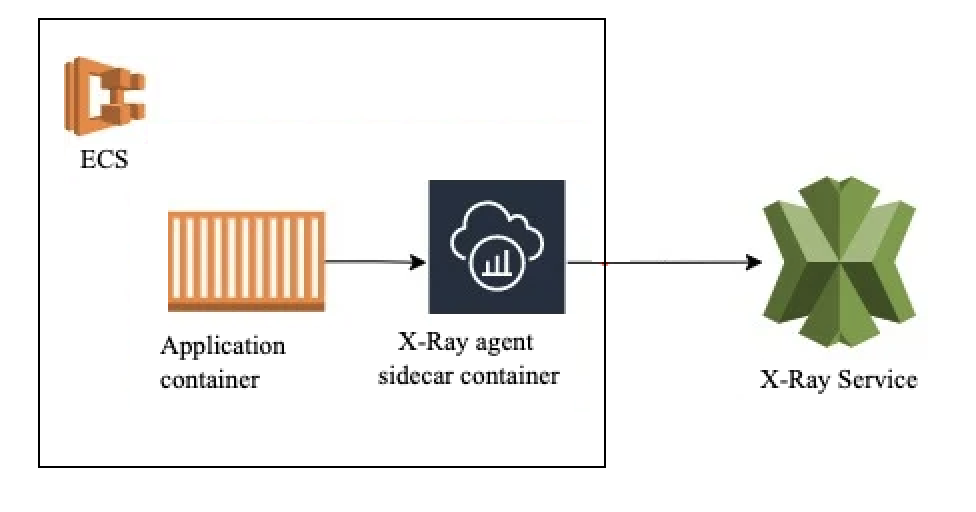ECS における AWS X-Ray を使用したトレーシング
モダンなアプリケーション開発の世界では、コンテナ化がアプリケーションのデプロイと管理における事実上の標準となっています。 Amazon Elastic Container Service (ECS) は、コンテナ化されたアプリケーションのデプロイと管理のための、高度にスケーラブルで信頼性の高いプラットフォームを提供します。 しかし、アプリケーションがより分散化され複雑になるにつれて、これらのアプリケーションの信頼性、パフォーマンス、効率性を確保するためにオブザーバビリティが重要になってきます。
AWS X-Ray は、ECS 上で実行されるコンテナ化されたアプリケーションのオブザーバビリティを向上させる、強力な分散トレーシングサービスを提供することでこの課題に対応します。 AWS X-Ray を ECS ワークロードと統合することで、アプリケーションの動作とパフォーマンスについてより深い洞察を得ることができる、様々な利点と機能を活用できます:
-
エンドツーエンドの可視性:AWS X-Ray は、コンテナ化されたアプリケーションと他の AWS サービスを通じてリクエストをトレースし、リクエストのライフサイクル全体のエンドツーエンドのビューを提供します。 この可視性により、異なるマイクロサービス間の相互作用を理解し、潜在的なボトルネックや問題をより効果的に特定できます。
-
パフォーマンス分析:X-Ray は、コンテナ化されたアプリケーションのリクエスト��レイテンシー、エラー率、リソース使用率などの詳細なパフォーマンスメトリクスを収集します。 これらのメトリクスにより、アプリケーションのパフォーマンスを分析し、パフォーマンスのホットスポットを特定し、リソース割り当てを最適化できます。
-
分散トレーシング:最新のマイクロサービスアーキテクチャでは、リクエストが複数のコンテナとサービスを横断することがよくあります。 AWS X-Ray は、これらの分散トレースの統合ビューを提供し、異なるコンポーネント間の相互作用を理解し、アプリケーション全体でパフォーマンスデータを相関付けることができます。
-
サービスマップの可視化:X-Ray は、アプリケーションのコンポーネントとその相互作用を視覚的に表現する動的なサービスマップを生成します。 これらのサービスマップは、マイクロサービスアーキテクチャの複雑さを理解し、最適化やリファクタリングの可能性のある領域を特定するのに役立ちます。
-
AWS サービスとの統合:AWS X-Ray は、AWS Lambda、API Gateway、Amazon ECS、Amazon EKS など、幅広い AWS サービスとシームレスに統合されます。 この統合により、複数のサービスにまたがるリクエストをトレースし、他の AWS サービスからのログやメトリクスとパフォーマンスデータを相関付けることができます。
-
カスタムインストルメンテーション:AWS X-Ray は多くの AWS サービスに対してすぐに使えるインストルメンテーションを提供しますが、AWS X-Ray SDK を使用してカスタムアプリケーションやサービスをインス�トルメント化することもできます。 この機能により、コンテナ化されたアプリケーション内のカスタムコードのパフォーマンスをトレースおよび分析でき、アプリケーションの動作をより包括的に把握できます。
 図 1:ECS から X-Ray へのトレーシングの送信
図 1:ECS から X-Ray へのトレーシングの送信
ECS ワークロードのオブザーバビリティを向上させるために AWS X-Ray を活用するには、以下の一般的な手順に従う必要があります:
-
カスタムアプリケーションのインストルメント化:AWS X-Ray SDK を使用してコンテナ化されたアプリケーションをインストルメント化し、トレースデータを X-Ray に送信します。
-
インストルメント化されたアプリケーションのデプロイ:インストルメント化されたコンテナアプリケーションを Amazon ECS クラスターまたはサービスにデプロイします。
-
トレースデータの分析:AWS X-Ray コンソールまたは API を使用してトレースデータを分析し、サービスマップを表示し、コンテナ化されたアプリケーション内のパフォーマンスの問題やボトルネックを調査します。
-
アラートと通知の設定:X-Ray メトリクスに基づいて CloudWatch アラームと通知を設定し、ECS ワークロードのパフォーマンス低下や異常に関するアラートを受け取ります。
-
他のオブザーバビリティツールとの統合:AWS X-Ray を AWS CloudWatch Logs、Amazon CloudWatch Metrics、AWS Distro for OpenTelemetry などの他のオブザーバビリティツールと組み合わせて、コンテナ化されたアプリケーションのパフォーマンス、ログ、メトリクスの包括的なビューを得ます。
AWS X-Ray は ECS ワークロードに対して強力なトレーシング機能を提供しますが、トレースデータの量とコスト管理などの潜在的な課題を考慮することが重要です。 コンテナ化されたアプリケーションがスケールアップし、より多くのトレースデータを生成するにつれて、コストを効果的に管理するためにサンプリング戦略を実装したり、トレースデータの保持ポリシーを調整したりする必要があるかもしれません。
さらに、トレースデータに対する適切なアクセス制御とデータセキュリティの確保が重要です。 AWS X-Ray は、保存時および転送時のトレースデータの暗号化と、トレースデータの機密性と整合性を保護するための詳細なアクセス制御メカニズムを提供します。
結論として、AWS X-Ray と Amazon ECS ワークロードの統合は強力な